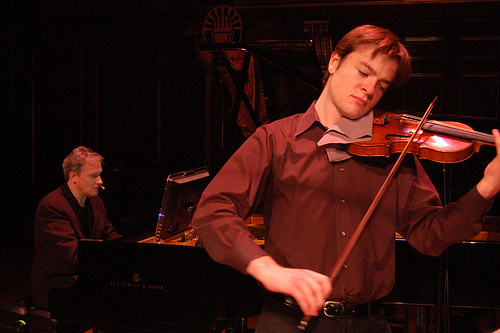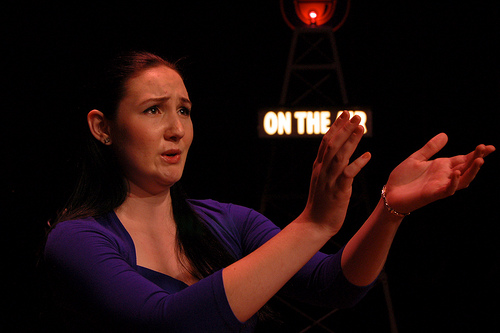Show 226: Listening Guide
This week’s From the Top’s broadcast was taped at New England Conservatory’s Jordan Hall in Boston, MA on Saturday January 29, 2011. We asked our performers to tell us about the music they performed on the show:
Samuel Katz, 17, violin
Spring Breeze
By: Edward Kalendar
Perhaps the highlight of this piece for me was that I had the opportunity to premiere the sonata 40 years after it was composed. Being the first person to have performed the “Spring Breeze” sonata by Edward Kalendar was a great honor and certainly a memorable experience. Mr. Kalendar received much of his inspiration for this sonata after studying with Aram Khachaturian over forty years ago. The first images or feelings I associated with this sonata were mountainous regions during the spring; in summary, a very warm yet cool and refreshing spring breeze. This was in fact the composer’s intention; it was well portrayed in the music. Another feature I found fascinating about this sonata is that the original themes and motifs are from eastern/oriental descent; however, the structure of the sonata clearly has its roots firmly planted in the western style of writing.
In comparison to other works that I’ve played by Brahms, Bach Mozart, Tchaikovsky, etc., with this piece, I have had the opportunity to collaborate with the composer of the work I am playing. Collaborating with Kalendar has been overall a wonderful experience, both educationally and inspirationally. Mr. Kalendar expresses a very warm and radiant passion for music; he is entirely devoted to music, consumed by it every minute. In addition to being a wonderful classical composer, he is also superb jazz musician. This man has inspired me tremendously with his overwhelming love for music.
Samantha Hankey,18,mezzo soprano
“Que fais-tu, blanche tourterelle” from Romeo et Juliette
By: Charles Gounod
When I first heard “Q ue fasi-tu”, I was so entertained by the humorous, lively music and how hard it was vocally. I enjoy singing this Aria because the character, Stefano, is so naïve and over-the-top that I can really play with many kinds of expression. This piece has definitely pushed me to a new level of character development, and has helped me explore the top of my range because of the flashy ending.
ue fasi-tu”, I was so entertained by the humorous, lively music and how hard it was vocally. I enjoy singing this Aria because the character, Stefano, is so naïve and over-the-top that I can really play with many kinds of expression. This piece has definitely pushed me to a new level of character development, and has helped me explore the top of my range because of the flashy ending.
The interesting fact about this piece from Romeo et Juliette is that the character Stefano is not in Shakespeare’s play, but was added into the opera by the librettist! “Que fais-tu” is my first piece that dramatically challenged me in a way different than in all of my other repertoire; acting immature and mocking. These two elements are really important for me to express. When I think that I’m going too far, it’s probably just right for this Aria! One aspect that I both love and hate is the melisma at the end, it’s so hard! The highest note in the piece is a high C, and when I get it right, it’s so rewarding!
Mackenzie Melemed, 15, piano
Sonata No.3 in A minor, Op.28
By: Sergei Prokofiev
Prokofiev’s music connects with me very much. I can understand him through his music and know his feelings and way of life. I love the slow snake-like section after the exposition. Prokofiev brings me much success, good luck composer, love playing his surprisingly “not-as-difficult-as-it seems” sonatas and concerti.
This piece has won me many competitions and helped the furthering of my career. Prokofiev’s music gets me excited to think that other people will understand my/its story, and imagine a plot during my performance. The motifs, themes, and intricacies are fabulous, and I wish to inspire and mesmerize all who listen.
Walnut Hill Sextet
Sextet for Piano and Wind Instruments
By: Francis Poulenc
Michal Zeleny, 18, flute
This piece has a very nice mix of melodic/technical passages. One of my favorite parts of this piece is when the flute/oboe have duets. This happens throughout the piece and at times gets very intense. If I were to imagine a story about this part it would be about a person’s dangerous and arduous journey at some point in his life.
This piece has many challenging technical passages and very strong climaxes, which make ensemble and intonation a key aspect of the piece, which the group has to work on. Personally I love the piece very much. Other pieces seem boring compared to it.
Walnut Hill Sextet
Sam Waring, 17, Oboe
I think the piece has a metropolitan energy to it and I think about that when I play it. I really enjoy the climax of these slow sections; it always sends tingles down my spine
I have performed a lot of woodwind quintets before, but never a woodwind quintet plus piano. The addition of the piano adds a lot of complexity to the piece. I also feel that each part is equal, which is different from many pieces I have played in the past.
Walnut Hill Sextet
Nicholas Davies. 17, clarinet
I find this piece, the Poulenc sextet, to be a truly memorable masterpiece – a work of excitement expressed through chromaticism and dissonance, and yet beautiful and powerful at the same time. While the piece seems more abstract than having a real “story” or “image”, the piece draws on the basic emotions – amusement and comedy – and transforms them into the more complex – sadness, loss and dying.
This piece, while perhaps simple on the outside, is extremely complex and extremely difficult, both ensemble and balance-wise. The intricate voice-weaving – typical of Poulenc – is very evident here, and to be able to maintain that consistent, steady flow is very hard. Otherwise, when it is perfectly together with the correct musical inflections/interpretations, it really comes to life and makes you feel the whole spectrum of emotions.
Walnut Hill Sextet
David Cornelius, 18, bassoon
My thought about this piece is it’s a unique piece because the piano adds a lot to it. It’s a woodwind quintet plus piano, where the piano has big artistic characteristics in the piece. My favorite part is the bassoon solo. My least favorite part is when it’s over. We preformed this piece at a cartoon festival.
The Poulenc is really out there, but full with excitement compared to other pieces I’ve played, like Mozart or Weber. When I play it I try to get across this French busy city theme; just a lot of busy things going on. The hardest part is probably the beginning.
Walnut Hill Sextet
Natasha Ramanujam, 18, French horn
For me, the opening of the Poulenc Sextet paints a vivid image of a busy Parisan scene where EVERYONE is in a rush to be somewhere. The first third of the piece reflects the chaotic day but once we get into the slow section, the scene dramatically changes and we enter a mysterious crime scene. We spend this section trying to find the answer to the crime and near the end of the section, it seems that we’re just an inch away from the answer but before we know it, day breaks and it’s time to resume life in the city.
Compared to the other chamber works I’ve performed, the Poulenc Sextet is extremely unique in that rarely does one instrument actually complete a full musical phrase. The entire piece is spent passing the melodic line from one to the other, which makes it a lot of fun because we really get to interact with one another while we’re playing but it also makes it quite difficult in terms of coordinating all of the pass-offs.
Walnut Hill Sextet
Hai-Yun Song, 15, piano
I think the piece is a good example of Neo-classical 20th century music and is particularly interesting for its accentuation and exaggeration. This piece is mostly fast and flies by, so I really enjoy the slow section!
The rhythm in this piece is very special and is what keeps the piece going. I have to take control of the rhythm throughout the music, and it is quite difficult. The chords are usually very abnormal and dissonant, and make intonation very difficult.




